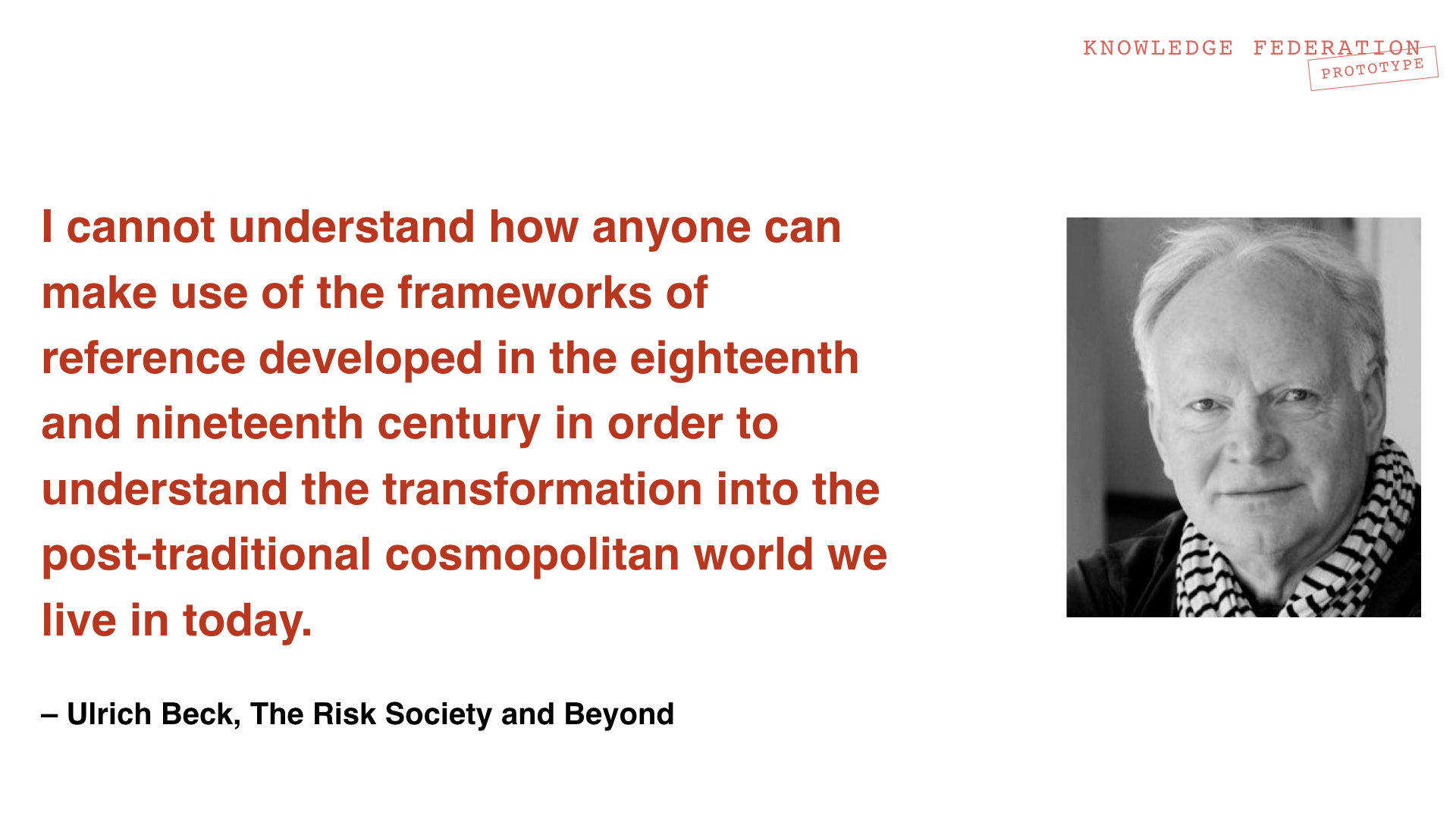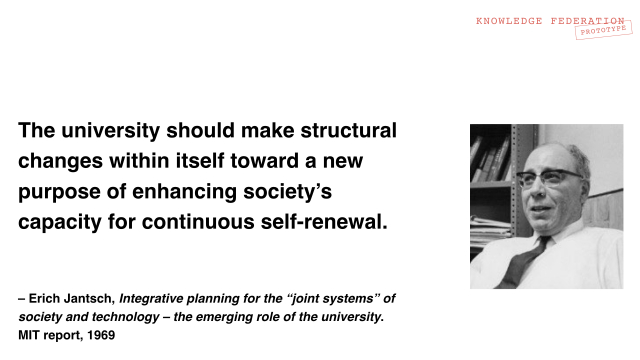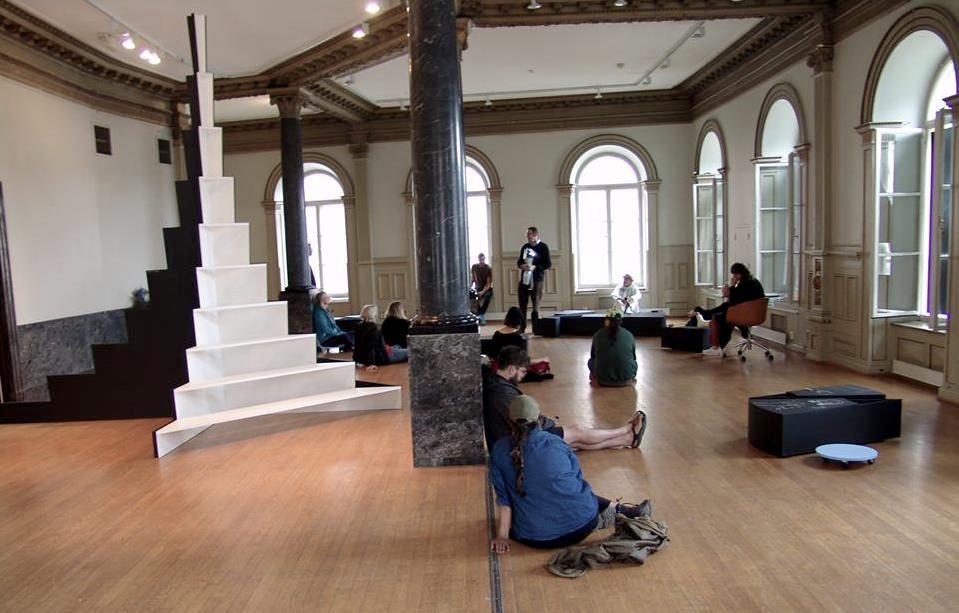Difference between revisions of "Holotopia"
m |
m |
||
| Line 796: | Line 796: | ||
<p>The book "Liberation" subtitled "Religion beyond Belief" is an ice breaker. It <em>federates</em> "the best kept secret", and creates a <em>dialog</em>. </p> | <p>The book "Liberation" subtitled "Religion beyond Belief" is an ice breaker. It <em>federates</em> "the best kept secret", and creates a <em>dialog</em>. </p> | ||
| + | </div> </div> | ||
| − | + | BBB --> | |
| − | |||
<div class="row"> | <div class="row"> | ||
| Line 804: | Line 804: | ||
<div class="col-md-7"> | <div class="col-md-7"> | ||
| − | <p>The <em>five insights</em> | + | <p>The <em>five insights</em> together compose a vision of "a great cultural revival". They complete the analogy between our time and the situation at the twilight of the Middle Ages and the dawn of the Renaissance, which we've been pointing to by using the iconic image of Galilei in house arrest.</p> |
| − | |||
| − | |||
<h3>A revolution in innovation</h3> | <h3>A revolution in innovation</h3> | ||
| − | <p>By bringing a radical improvement of the efficiency and effectiveness of human work, through innovation, the Industrial Revolution | + | <p>By bringing a radical improvement of the efficiency and effectiveness of human work, through innovation, the Industrial Revolution promised to liberate our ancestors from hardship and toil, so that they may focus on developing culture and "human quality". The <em>power structure</em>, however, thwarted our aspirations. This issue can be resolved, and progress can be resumed, by learning to "make things whole" on the level of <em>the systems in which we live and work</em>.</p> |
| − | |||
| − | |||
<h3>A revolution in communication</h3> | <h3>A revolution in communication</h3> | ||
| − | <p>The printing press enabled the Enlightenment by enabling a revolution in literacy | + | <p>The printing press enabled the Enlightenment by enabling a revolution in literacy and communication. The <em>collective mind</em> insight shows that the new information technology can power a <em>similar</em> revolution—whose effect will be a revolution of <em>meaning</em>. The kind of revolution that can make the differences that needs to make, in a post-industrial society.</p> |
| − | <h3>A revolution in | + | <h3>A revolution in the relationship we have with information</h3> |
| − | <p> | + | <p>By reviving the academic tradition (which had remained dormant for almost two thousand years), the Enlightenment empowered our ancestors to use reason to comprehend the world, and to evolve faster. The <em>socialized reality</em> insight shows that the evolution of the academic tradition has brought us to a new turning point—which will liberate us from <em>reifying</em> our inherited <em>systems</em> and worldviews; and to enable our culture to evolve in a similar way and at a similar rate as science and technology have been evolving. This <em>fundamental</em> change will empower us to be creative in ways and on the scale that a "great cultural revival" requires.</p> |
<h3>A revolution in method</h3> | <h3>A revolution in method</h3> | ||
| Line 828: | Line 824: | ||
<h3>A revolution in culture</h3> | <h3>A revolution in culture</h3> | ||
| − | <p>The Renaissance <em>was</em> a "great cultural revival"—a liberation and celebration of life, love, and beauty, by changing the values and the lifestyle, and developing the arts. The <em>convenience paradox</em> insight | + | <p>The Renaissance <em>was</em> a "great cultural revival"—a liberation and celebration of life, love, and beauty, by changing the values and the lifestyle, and developing the arts. The <em>convenience paradox</em> insight shows that our culture has once again become a victim of <em>power structure</em>; and that the liberation will lead us to a whole new <em>way</em> of evolving.</p> |
| − | |||
| − | |||
</div> </div> | </div> </div> | ||
| − | + | XXX --> | |
| − | |||
<div class="row"> | <div class="row"> | ||
| Line 886: | Line 879: | ||
</div> </div> | </div> </div> | ||
| − | <b><BIG>This Holotopia project description will be completed by elaborating | + | <b><BIG>This Holotopia project description will be completed by elaborating:</BIG></b> |
<div class="page-header" ><h2>A strategy</h2></div> | <div class="page-header" ><h2>A strategy</h2></div> | ||
Revision as of 08:50, 29 August 2020
Contents
HOLOTOPIA
An Actionable Strategy
Imagine...
You are about to board a bus for a long night ride, when you notice the flickering streaks of light emanating from two wax candles, placed where the headlights of the bus are expected to be. Candles? As headlights?
Of course, the idea of candles as headlights is absurd. So why propose it?
Because on a much larger scale this absurdity has become reality.
The Modernity ideogram renders the essence of our contemporary situation by depicting our society as an accelerating bus without a steering wheel, and the way we look at the world, try to comprehend and handle it as guided by a pair of candle headlights.
A great cultural revival
The five insights together compose a vision of "a great cultural revival". They complete the analogy between our time and the situation at the twilight of the Middle Ages and the dawn of the Renaissance, which we've been pointing to by using the iconic image of Galilei in house arrest.
A revolution in innovation
By bringing a radical improvement of the efficiency and effectiveness of human work, through innovation, the Industrial Revolution promised to liberate our ancestors from hardship and toil, so that they may focus on developing culture and "human quality". The power structure, however, thwarted our aspirations. This issue can be resolved, and progress can be resumed, by learning to "make things whole" on the level of the systems in which we live and work.
A revolution in communication
The printing press enabled the Enlightenment by enabling a revolution in literacy and communication. The collective mind insight shows that the new information technology can power a similar revolution—whose effect will be a revolution of meaning. The kind of revolution that can make the differences that needs to make, in a post-industrial society.
A revolution in the relationship we have with information
By reviving the academic tradition (which had remained dormant for almost two thousand years), the Enlightenment empowered our ancestors to use reason to comprehend the world, and to evolve faster. The socialized reality insight shows that the evolution of the academic tradition has brought us to a new turning point—which will liberate us from reifying our inherited systems and worldviews; and to enable our culture to evolve in a similar way and at a similar rate as science and technology have been evolving. This fundamental change will empower us to be creative in ways and on the scale that a "great cultural revival" requires.
A revolution in method
Galilei in house arrest was really science in house arrest. It was this new way to understand the natural phenomena that liberated our ancestors from superstition, and empowered them to understand and change their world by developing technology. The narrow frame insight shows that the "project science" can and needs to be extended into all walks of life—to illuminate all those core issues that science left in the dark.
A revolution in culture
The Renaissance was a "great cultural revival"—a liberation and celebration of life, love, and beauty, by changing the values and the lifestyle, and developing the arts. The convenience paradox insight shows that our culture has once again become a victim of power structure; and that the liberation will lead us to a whole new way of evolving.
XXX -->
The sixth insight
When the five insights are combined together, they readily lead to a more general sixth insight, which is even more germane to the holotopia's message and spirit. The sixth insight may be roughly formulated as follows:
To change anything, we need to change the whole thing.
The reason is the close co-dependence of both the structural problems the five insights reveal, and of their solutions.
We have seen (while exploring the power structure insight) that we will not be able to resolve the characteristic contemporary issues and resume our cultural and societal evolution, unless we learned to direct our power to innovate by using suitable information and knowledge, instead of the "free competition" and the market. But that requires (as we have seen while exploring the collective mind insight) that we restore the severed tie between information and action—that instead of merely broadcasting information, we learn to federate the insights that can motivate and inform action. This, however (as the socialized reality insight showed) requires that we change the relationship we have with information—from considering it as a mirror image of reality, to considering it a vital element of our core systems, which must be adapted to the purposes it needs to serve within those systems.
When that is done (the narrow frame insight showed)—the opportunity opens up to create "the way we look at the world, try to comprehend and handle it", to be used both by academic researchers who wish to work in this way, and the general public. And when that is in place (we showed while exploring the convenience paradox insight), the resulting informed way of "pursuing happiness" will lead to completely different values, and direction. Furthermore, the values that result will be exactly those that are needed to empower us to resolve the power structure issue, by self-organizing and co-creating systems that resolve our problems. This closes the circle.
A strategic insight results:
A large change may be easy; small changes may be difficult or impossible.
But a large and comprehensive change has its own logic, or process, or "leverage points".
And the most powerful kind of leverage point, Donella Meadows pointed out, is "the power to transcend paradigms". It is exactly that power that we are proposing to restore.
We summarize the case for our proposal by a warning reaching us from sociology.
Beck continued the above observation:
"Max Weber's 'iron cage' – in which he thought humanity was condemned to live for the foreseeable future – is for me the prison of categories and basic assumptions of classical social, cultural and political sciences."
The 'candle headlights' (inheriting the way we look at the world, try to comprehend it and handle it) is what keeps us in 'iron cage'.
A created way, modeled by the holoscope, is an academically rigorous way out.
The holotopia is offered as the vision that results.
The Holotopia project is conceived as a way to streamline the actualization of that vision.
When making this proposal, we are not saying anything new; we are indeed only federating the call to action that many have made before us.
We are now, however, backing their calls to action and ideas by federating them, and showing that they form a consistent and complete academic paradigm.
This Holotopia project description will be completed by elaborating:
A strategy
The Holotopia project is conceived as a co-creative strategy game.
The project is conceived as a space—where we are empowered to use our creativity to "change course", and create a future. This "future", however, begins instantly.
We implement a strategy that federates Margaret Mead's specific insights, how to respond to the situation we are in :
"(W)e are living in a period of extraordinary danger, as we are faced with the possibility that our whole species will be eliminated from the evolutionary scene. One necessary condition of successfully continuing our existence is the creation of an atmosphere of hope that the huge problems now confronting us can, in fact, be solved—and can be solved in time."
Tactical assets
To the above co-creative space we bring a portfolio of assorted tactical assets.
A pilot project





